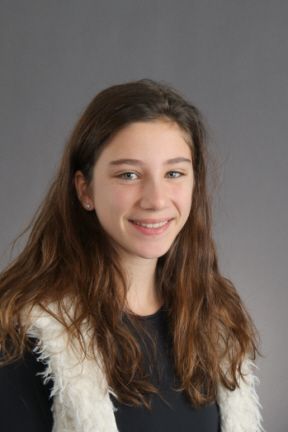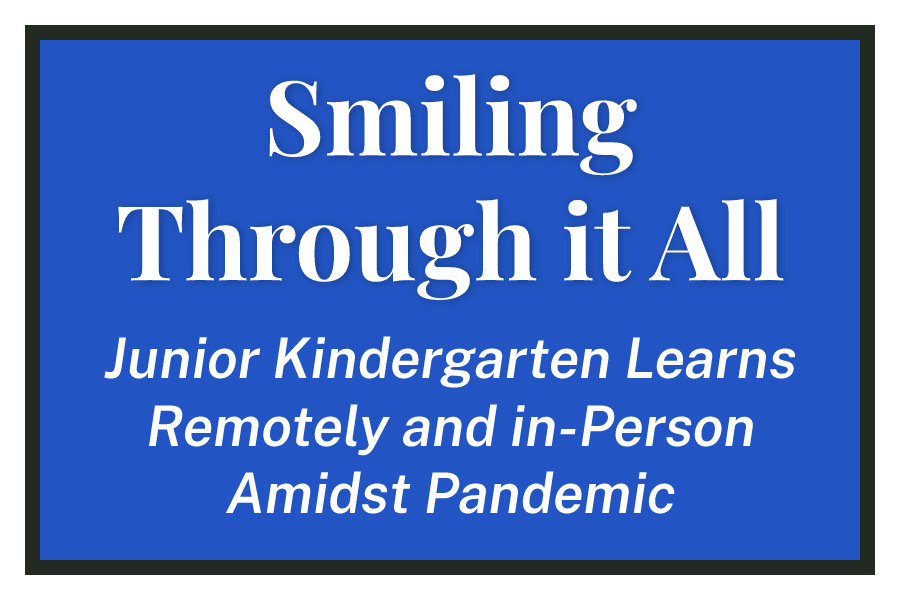Smiling Through it All
Junior Kindergarten Learns Remotely and in-Person Amidst Pandemic
Instead of tired eyes and turned-off cameras, in a remote JK class the Zoom boxes are filled with smiling faces, sleeping kids, stuffed animals shoved in front of the camera, waving family members, and shaky images as they walk around the house.
The entire kindergarten started out the year learning in-person, and then went remote following the weeks of Thanksgiving and winter break. While in-person, no positive COVID-19 cases were reported in any of the three JK classes. According to Lower School Director of Studies Barbara Hunt, the Lower School staff is “a well-oiled ship,” because everyone works well together and does their part to ensure the safety of both the students and the faculty.
During in-person learning, each kindergarten class is split into two pods, A and B, with nine to ten students per pod. Families who chose to opt out of sending their kids in-person were able to enroll in a separate remote program. The JK staff still utilizes the regular classrooms, with the new addition of desks, for learning and playtime, but also spends a majority of class time outdoors, both on- and off-campus at the Lincoln Park Zoo, Bailey Garden, or Webster parking lot, when the weather permits.
“They really do crave that interaction,” Early Learning Resource Specialist Meagan Mitchell said. “Even though they were in smaller pods, masked, and more than six feet apart, they just love being around other kids.”
Previously a social worker in Washington DC, Mitchell’s position this year is new and mostly involves supporting students in hitting all the standard academic and social developmental milestones for their age. While her job normally entails meeting with students one on one, during remote learning she started teaching lessons with entire classes. During those lessons, Mitchell noticed the difference in some kids’ participation levels in a remote setting.
“It’s been nice to see some kids that maybe were a little more reserved in school, and once they got on Zoom they were talking much more,” she said. Engagement levels for each student also tend to vary day by day depending on whether or not they’re in the mood to talk. Either is accepted in a JK classroom setting.
Before Mitchell’s lessons, every day of remote learning began with a “morning meeting” at 8:30 a.m., which usually consisted of a literacy or math lesson. Before jumping into the learning, students took some time to say their “good mornings” and adjust to being on the Zoom meeting. Later on, one of the teachers introduced a Social-Emotional Learning (SEL) question that targeted a certain concept, for example, the word fair.
In addition to discussion, the morning meetings also included some hands-on time. In anticipation of remote learning, the lower school faculty sent each student home with a “toolbox” of materials at the beginning of the year to ensure that every kid has the best possible experience no matter what they may or may not already have to work with. For JK students, the boxes included a wide variety of items to play and learn with in class, such as chalkboards for letters and numbers, modeling clay, watercolors, and beads. Students were allowed the freedom to decide if they wanted to join in on using the certain item the teacher was using that day or instead play with something else.
“We’re trying to give a lot of organic experiences as much as we can in terms of different ways of interacting with each other so it doesn’t get stale, and also to try to meet the different needs of each kid,” JK teacher Tisha Johnson said. She also noted that it’s very common to see all 20 kids doing something different while she’s speaking, but as long as they’re not being disruptive to the group, then it’s allowed. While each day brought a new variety of tasks, most students always showed up with smiles on their faces ready to share and connect with each other.
PE class offers an entirely new way for the students to interact, especially because they get to spend it with their classmates from other pods. At the beginning of the school year, JK’s in-person gym class was outside on the field with cones and ropes to section off different groups of students. However, as the temperatures dropped, they were forced to move inside. Additional teachers and new sanitation protocols helped keep classes running smoothly.
Gym classes continued to meet weekly during periods of remote learning. In addition to their class toolboxes, each student also received a “PE essentials bag,” with an assortment of toys and equipment geared towards indoor activities. The materials are used both in-person in order to reduce cross-contamination and in their homes over Zoom. After a little music and dancing to start off the remote classes, they’d play games similar to Simon Says or a mini scavenger hunt for items in their bags.
PE teacher Jan Zoufal was very impressed with how the kids handled the unique situation, saying that the students “did an unbelievable job and were so much fun to work with.” Because she was teaching an activity-based class where students could move around freely, Zoufal found that it wasn’t as hard for them to stay focused online.
Though it was a rocky start for all classes technology-wise, the students quickly learned how to join meetings and use the mute button when it wasn’t their turn to talk. The tech-department helped by streamlining the joining process through an app pushed out to the school-issued JK iPads. From there, students can see a shared Google Spreadsheet with links that the teachers updated daily in the weeks of remote learning.
The lower school faculty was committed to no more than 120 minutes of Zoom time a day and spaced the online schedules with breaks between 20-30 minute sessions of learning. The kindergarten schedule for in-person learning is full-day this year. While parents are encouraged to take their kids home at 11:45 am for a break, other options for staying at school during those times are available.
“[The kids] are very able to adapt,” Mitchell said. “You could see as we went through the weeks that they got much more comfortable with it and were really able to take this on.”
Hunt agreed that “what’s happening is still really good given the circumstances. It’s different, it’s not that Parker-y the way we like it to be, but it’s time for the kids and they’re still getting a good experience with it.”
Johnson saw a similar positive attitude among the students. “You can see their eyes and their smiles light up every day,” she said. “They’re really truly happy to be together.”








